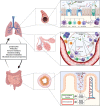Microbiome-immune interactions in tuberculosis
- PMID: 33857251
- PMCID: PMC8049499
- DOI: 10.1371/journal.ppat.1009377
Microbiome-immune interactions in tuberculosis
Abstract
Tuberculosis (TB) remains an infectious disease of global significance and a leading cause of death in low- and middle-income countries. Significant effort has been directed towards understanding Mycobacterium tuberculosis genomics, virulence, and pathophysiology within the framework of Koch postulates. More recently, the advent of "-omics" approaches has broadened our appreciation of how "commensal" microbes have coevolved with their host and have a central role in shaping health and susceptibility to disease. It is now clear that there is a diverse repertoire of interactions between the microbiota and host immune responses that can either sustain or disrupt homeostasis. In the context of the global efforts to combatting TB, such findings and knowledge have raised important questions: Does microbiome composition indicate or determine susceptibility or resistance to M. tuberculosis infection? Is the development of active disease or latent infection upon M. tuberculosis exposure influenced by the microbiome? Does microbiome composition influence TB therapy outcome and risk of reinfection with M. tuberculosis? Can the microbiome be actively managed to reduce risk of M. tuberculosis infection or recurrence of TB? Here, we explore these questions with a particular focus on microbiome-immune interactions that may affect TB susceptibility, manifestation and progression, the long-term implications of anti-TB therapy, as well as the potential of the host microbiome as target for clinical manipulation.
Conflict of interest statement
The authors have declared that no competing interests exist.
Figures



References
-
- World Health Organization. Global tuberculosis report 2020.
Publication types
MeSH terms
Substances
LinkOut - more resources
Full Text Sources
Other Literature Sources
Medical

